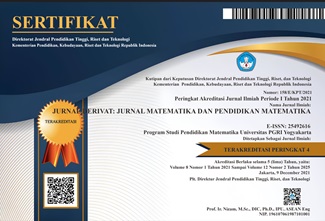Pengaruh Model Connected Mathematics Project Terhadap Kemampuan Pemahaman Konsep Matematika Ditinjau Dari Adversity Quotient
DOI:
https://doi.org/10.31316/j.derivat.v11i3.6585Abstract
This study aimed to determine whether the Connected Mathematics Project (CMP) instructional model enhances students' conceptual understanding compared to conventional teaching methods. Additionally, the research assessed differences in students' conceptual understanding based on their Adversity Quotient (AQ) categories: climbers, campers, and quitters. Furthermore, the study investigated whether there is an interaction between the CMP instructional model and Adversity Quotient in influencing students' conceptual understanding. The method employed was a quasi-experimental design with a posttest-only control group. The sample consisted of XI MIPA 2 as the experimental group and XI MIPA 4 as the control group. Data were collected using both test and non-test methods, and data analysis utilized a two-way analysis of variance (ANOVA). The findings revealed that the CMP instructional model significantly enhances students' conceptual understanding compared to the conventional model. Moreover, students categorized as climbers in AQ demonstrated better conceptual understanding compared to campers, while campers showed similar performance to quitters. Students with adversity quotient climbers exhibited better conceptual understanding than those with adversity quotient quitters. There was an interaction between the instructional model and adversity quotient in influencing conceptual understanding.
Keywords: Adversity quotient, CMP, Conceptual understanding
References
Abidin, Z., Utomo, A. C., Pratiwi, V., Farokhah, L., Jakarta, U. B., & Jakarta, U. M. (2020). Project-based learning-literacy in improving students’ mathematical reasoning abilities in elementary schools. JMIE (Journal of Madrasah Ibtidaiyah Education), 4(1), 39–52.
Aditya, D. Y., & Julaeha, S. (2020). Meningkatkan Pemahaman Konsep Matematika Melalui Model Pembelajaran Core. SINASIS (Seminar Nasional Sains), 1(1).
Aung, P., & San, A. (2020). Adversity quotient and academic stress of students from universities of education. Journal of the Myanmar Academy of Arts and Science., XVIII B, 9, 647–658.
Bien, Y. I., Daniel, F., Taneo, P. N. L., Matematika, P. P., & Stkip, S. (2019). PENGEMBANGAN BUKU AJAR KALKULUS INTEGRAL BERBASIS MAPLE UNTUK MENINGKATKAN PEMAHAMAN KONSEP MAHASISWA. 2(1). http://jurnal.umk.ac.id/index.php/anargya
Dinar, I. R., & Rabbani, S. (2022). Pembelajaran pemahaman matematika pengukuran berat pada siswa sd kelas ii dengan menggunakan model contextual teaching and learning. COLLASE (Creative of Learning Students Elementary Education), 5(2), 400–408.
Farhana, A., & Amelia, S. (2022). Ketertarikan Peserta Didik Belajar Matematika Menggunakan LKPD dengan Model Connected Mathematics Project (CMP). INOMATIKA, 4(1), 56–67.
Hidayat, W., & Aripin, U. (2019a). The improvement of students’ mathematical understanding ability influenced from argument-driven inquiry learning. Journal of Physics: Conference Series, 1157(3). https://doi.org/10.1088/1742-6596/1157/3/032085
Hidayat, W., & Aripin, U. (2019b). The improvement of students’ mathematical understanding ability influenced from argument-driven inquiry learning. Journal of Physics: Conference Series, 1157(3), 032085.
Hidayat, W., Noto, M. S., & Sariningsih, R. (2019). The influence of adversity quotient on students’ mathematical understanding ability. Journal of Physics: Conference Series, 1157(3), 032077. https://doi.org/10.1088/1742-6596/1157/3/032077
Hulaikah, M., Degeng, I., & Murwani, F. D. (2020). The Effect of Experiential Learning and Adversity Quotient on Problem Solving Ability. International Journal of Instruction, 13(1), 869–884.
Nugroho, A. M., Wardono, W., Waluyo, S. B., & Cahyono, A. N. (2019). Kemampuan Berpikir Kreatif ditinjau dari Adversity Quotient pada Pembelajaran TPACK. PRISMA, Prosiding Seminar Nasional Matematika, 2, 40–45.
Radiusman, R. (2020). Studi Literasi: Pemahaman konsep anak pada pembelajaran matematika. FIBONACCI: Jurnal Pendidikan Matematika Dan Matematika, 6(1), 1–8.
Septiani, D., Rahayu, G. D. S., & Hendriana, H. (2022). Pembelajaran dengan Menggunakan Pendekatan Realistic Mathematic Education untuk Mengukur Pemahaman Konsep Matematika tentang Bangun Datar pada Siswa Sekolah Dasar Kelas IV. COLLASE (Creative of Learning Students Elementary Education), 5(1), 126–138.
Sitanggang, S. L., Syahputra, E., & Yus, A. (2020). The Effect of Problem Based Learning Model on Critical Thinking Ability Student Mathematics and Adversity Student Quotient on Students SMP Negeri 4 Lubukpakam. Budapest International Research and Critics in Linguistics and Education (BirLE) Journal, 3(4), 1773–1781.
Somaratne, C. S. N., Jayawardena, L., & Perera, B. M. K. (2020). Role of Adversity Quotient (AQ) on Perceived Stress of Managers: with specific reference to AQ Dimensions. Kelaniya Journal of Management, 8(2), 40.
Stoltz, P. G. (1999). Adversity quotient: Turning obstacles into opportunities. John Wiley & Sons.
Sundtjønn, T. (2021). Opportunities and challenges when students work with vocationally connected mathematics tasks.
Downloads
Published
Issue
Section
Citation Check
License
Copyright (c) 2025 Farra Aulia Rahmayanti, Nur Baiti Nasution

This work is licensed under a Creative Commons Attribution-ShareAlike 4.0 International License.
Authors who publish with this journal agree to the following terms:
-
Authors retain copyright and grant the journal right of first publication with the work simultaneously licensed under a Creative Commons Attribution-ShareAlike 4.0 International License that allows others to share the work with an acknowledgment of the work's authorship and initial publication in this journal.
- Authors are able to enter into separate, additional contractual arrangements for the non-exclusive distribution of the journal's published version of the work (e.g., post it to an institutional repository or publish it in a book), with an acknowledgment of its initial publication in this journal.
- Authors are permitted and encouraged to post their work online (e.g., in institutional repositories or on their website) prior to and during the submission process, as it can lead to productive exchanges, as well as earlier and greater citation of published work (See The Effect of Open Access).







